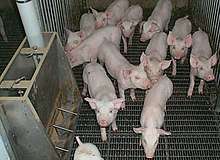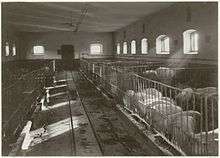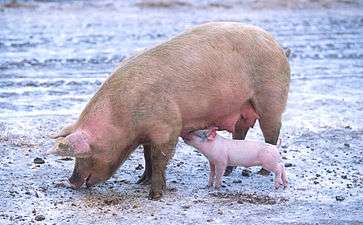Pig farming


Pig farming is the raising and breeding of domestic pigs as livestock, and is a branch of animal husbandry. Pigs are farmed principally to be eaten (e.g. bacon, gammon) or sometimes skinned.
Pigs are amenable to many different styles of farming: intensive commercial units, commercial free range enterprises, or extensive farming (being allowed to wander around a village, town or city, or tethered in a simple shelter or kept in a pen outside the owner’s house). Historically, farm pigs were kept in small numbers and were closely associated with the residence of the owner, or in the same village or town.[1] They were valued as a source of meat, fat and for the ability to turn inedible food into meat, and often fed household food waste if kept on a homestead. Pigs have been farmed to dispose of municipal garbage on a large scale.[2]
All these forms of pig farm are in use today. In developed nations, commercial farms house thousands of pigs in climate-controlled buildings.[3] Pigs are a popular form of livestock, with more than one billion pigs butchered each year worldwide, 100 million of them in the USA. The majority of pigs are used for human food but also supply skin, fat and other materials for use as clothing, ingredients for processed foods,[4] cosmetics,[5] and medical use.[6]
The activities on a pig farm depend on the husbandry style of the farmer, and range from very little intervention (as when pigs are allowed to roam villages or towns and dispose of garbage) to intensive systems where the pigs are contained in a building for the majority of their lives. Each pig farm will tend to adapt to the local conditions and food supplies and fit their practices to their specific situation.
The following factors can influence the type of pig farms in any given region:
- Available food supply suitable for pigs
- The ability to deal with manure or other outputs from the pig operation
- Local beliefs or traditions, including religion
- The breed or type of pig available to the farm
- Local diseases or conditions that affect pig growth or fecundity
- Local requirements, including government zoning and/or land use laws
- Local and global market conditions and demand
Use as food
Almost all of the pig can be used as food. Preparations of pig parts into specialties include: sausage (and casings made from the intestines), bacon, gammon, ham, skin into pork scratchings, feet into trotters, head into a meat jelly called head cheese (brawn), and consumption of the liver, chitterlings and blood (blood pudding or black pudding). This is also, technically, the case for all other mammals, although the demand is not really there.
Production and trade
| Global pig stocks in 2014 | |
| (million) | |
| 474.1 | |
| 67.7 | |
| 37.9 | |
| 28.3 | |
| 28.1 | |
| 26.8 | |
| 26.6 | |
| 19.1 | |
| 16.1 | |
| 13.9 | |
| World total | 986.6 |
| Source: UN Food & Agriculture Organisation (FAO) | |
Pigs are farmed in many countries, though the main consuming countries are in Asia, meaning there is a significant international and even intercontinental trade in live and slaughtered pigs. Despite having the world's largest herd, China is a net importer of pigs, and has been increasing its imports during its economic development. The largest exporters of pigs are the United States, the European Union, and Canada. As an example, more than half of Canadian production (22.8 million pigs) in 2008 was exported, going to 143 countries.[7] Older pigs will consume eleven to nineteen litres (three to five US gallons) of water per day.[8]
Relationship between handlers and pigs
The way in which a stockperson interacts with pigs affects animal welfare which in some circumstances can correlate with production measures. Many routine interactions can cause fear, which can result in stress and decreased production.
There are various methods of handling pigs which can be separated into those which lead to positive or negative reactions by the animals. These reactions are based on how the pigs interpret a handler’s behavior.
Negative interactions
Many negative interactions with pigs arise from stock-people dealing with large numbers of pigs. Because of this, many handlers can become complacent about animal welfare and fail to ensure positive interactions with pigs. Negative interactions include overly-heavy tactile interactions (slaps, punches, kicks and bites), the use of electric goads and fast movements. It can also include killing them. However, it is not a commonly held view that death is a negative interaction. These interactions can result in fear in the animals, which can develop into stress. Overly-heavy tactile interactions can cause increased basal cortisol levels (a "stress" hormone).[9] Negative interactions that cause fear mean the escape reactions of the pigs can be extremely vigorous, thereby risking injury to both stock and handlers. Stress can result in immunosuppression,[10] leading to an increased susceptibility to disease. Studies have shown that these negative handling techniques result in an overall reduction in growth rates of pigs.
Positive interactions
Various interactions can be considered either positive or neutral. Neutral interactions are considered positive because, in conjunction with positive interactions, they contribute to an overall non-negative relationship between a stock-person and the stock. Pigs are often fearful of fast movements. When entering a pen, it is good practice for a stock-person to enter with slow and deliberate movements. These minimize fear and therefore reduce stress. Pigs are very curious animals. Allowing the pigs to approach and smell whilst patting or resting a hand on the pig's back are examples of positive behavior. Pigs also respond positively to verbal interaction. Minimizing fear of humans allow handlers to perform husbandry practices in a safer and more efficient manner. By reducing stress, stock are made more comfortable to feed when near handlers, resulting in increased productivity.[11] In other words, pigs are very social and intelligent animals, and if they are treated well, better meat can be obtained. Prohand for pigs is a training program that teaches handlers to interact with pigs in a way that promotes safe handling. It promotes the development of positive behaviors and elimination of negative behaviors. This program has been seen to improve productivity without any capital investment.[12]
Terminology
Pigs are extensively farmed, and therefore the terminology is well developed:
- Pig, hog or swine, the species as a whole, or any member of it. The singular of "swine" is the same as the plural.
- Shoat, piglet or (where the species is called "hog") pig, unweaned young pig, or any immature pig.
- Sucker, a pig between birth and weaning.
- Weaner, a young pig recently separated from the sow.
- Runt, an unusually small and weak piglet, often one in a litter.
- Boar or hog, male pig of breeding age.
- Barrow, male pig castrated before puberty.
- Stag, male pig castrated later in life (an older boar after castration).
- Gilt, young female not yet mated, or not yet farrowed, or after only one litter (depending on local usage).[13]
- Sow, breeding female, or female after first or second litter.
Pigs for slaughter
(NRCS_Photo_Gallery).jpg)
- Suckling pig, a piglet slaughtered for its tender meat.
- Feeder pig, a weaned gilt or barrow weighing between 18 kg (40 lb) and 37 kg (82 lb) at 6 to 8 weeks of age that is sold to be finished for slaughter.
- Porker, market pig between 30 kg (66 lb) and about 54 kg (119 lb) dressed weight.
- Baconer, a market pig between 65 kg (143 lb) and 80 kg (180 lb) dressed weight. The maximum weight can vary between processors.
- Grower, a pig between weaning and sale or transfer to the breeding herd, sold for slaughter or killed for rations.
- Finisher, a grower pig over 70 kg (150 lb) liveweight.
- Butcher hog, a pig of approximately 100 kg (220 lb), ready for the market. In some markets (Italy) the final weight of butcher pig is in the 180 kg (400 lb) range. They to have hind legs suitable to produce cured ham.
- Backfatter, cull breeding pig sold for meat; usually refers specifically to a cull sow, but is sometimes used in reference to boars.
Groups
- Herd, a group of pigs, or all the pigs on a farm or in a region.
- Sounder, a small group of pigs (or wild boar) foraging in woodland.
Pig parts
- Trotters, the hooves of pigs (they have four hoofed toes on each foot, walking mainly on the larger central two).
Biology
- In pig, pregnant.
- Farrowing, giving birth.
- Hogging, a sow when on heat (during estrus).
Housing
- Sty, a small pig-house, usually with an outdoor run or a pig confinement.
- Pig-shed, a larger pig-house.
- Ark, a low semi circular field-shelter for pigs.
- Curtain-barn, a long, open building with curtains on the long sides of the barn. This increases ventilation on hot, humid summer days.
Environmental and health impacts
Industrial pig farming, a subset of CAFOs (concentrated animal feeding operations) poses numerous threats to environmental health and justice. Deforestation is a common occurrence under the placement of new farms. Feces and waste often spread to surrounding neighborhoods, polluting air and water with toxic waste particles.[14] Waste from swine on these farms carry a host of pathogens and bacteria as well as heavy metals. These toxins can leach down through the soil into groundwater, polluting local drinking water supplies. Pathogens can also become airborne, polluting the air and harming individuals when ingested.[15] Contents from waste have been shown to cause many detrimental health implications, as well as harmful algal blooms in surrounding bodies of water.[16]
Drug
Growth Promoter
Ractopamine
Most pigs in America get ractopamine to put on more muscle instead of fat, to put on weight more quickly, to reduce costs and to reduce pollutants in the environment because pigs on ractopamine do not need as much feed to reach finishing weight and do not produce as much manure. However, ractopamine has not been approved for use by the European Union, China, Russia and several other countries.[17]
Colistin (Antibiotic)
China once used colistin as growth promoter (subtherapeutic antibiotic use) but discovered of a colistin resistant form of E. coli bacteria in a pig from a Shanghai farm in 2013. Investigations then led to the identification of "a gene called MCR-1 that allowed bacteria to survive colistin treatment in animals and humans."[18] In 2016, these findings led China to ban colistin as growth promoter.[18][19]
Antibiotics
China uses sulfamethazine, bacitracin, chlortetracycline, tetracycline, florfenicol, sulfonamide, doxycycline, oxytetracycline, fluoroquinolone, macrolide, trimethoprim, and stopped using colistin as of 26 July 2016.[18][19]
See also
References
- ↑ Flisser, Ana; Ganaba, Rasmané; Praet, Nicolas; Carabin, Hélène; Millogo, Athanase; Tarnagda, Zékiba; Dorny, Pierre; Hounton, Sennen; Sow, Adama; Nitiéma, Pascal; Cowan, Linda D. (2011). "Factors Associated with the Prevalence of Circulating Antigens to Porcine Cysticercosis in Three Villages of Burkina Faso". PLoS Neglected Tropical Diseases. 5 (1): e927. doi:10.1371/journal.pntd.0000927. PMC 3014946. PMID 21245913.
- ↑ "Full text of "The collection and disposal of municipal waste"". Archive.org. Retrieved 6 October 2018.
- ↑ http://swine.missouri.edu/facilities/PIH-11.PDF
- ↑ "The Lost Art of Cooking With Lard". Mother Earth News. Retrieved 6 October 2018.
- ↑ "Ingredient: Lard". cosmeticsinfo.org. Retrieved 6 October 2018.
- ↑ "Material from pig intestine is remedy for deep sores, incontinence". Purdue.edu. Retrieved 6 October 2018.
- ↑ "Canadian Pork Exports". Canadapork.com. Retrieved 6 October 2018.
- ↑ http://www.ncsu.edu/project/swine_extension/healthyhogs/book1995/almond.htm
- ↑ Hemsworth, P.H (2003). "Human–animal interactions in livestock production". Applied Animal Behaviour Science. 81 (3): 185–98. doi:10.1016/S0168-1591(02)00280-0.
- ↑ Hemsworth PH, Coleman GJ, Barnett JL, Borg S (2000). "Relationships between human-animal interactions and productivity of commercial dairy cows". Journal of Animal Science. 78 (11): 2821–31. PMID 11063304.
- ↑ Hemsworth, P.H.; Price, E.O.; Borgwardt, R. (1996). "Behavioural responses of domestic pigs and cattle to humans and novel stimuli". Applied Animal Behaviour Science. 50 (1): 43–56. doi:10.1016/0168-1591(96)01067-2.
- ↑ http://www.animalwelfare.net.au/~awsc/sites/default/files/Brochure%20Prohand%20Pigs.pdf%5Bfull+citation+needed%5D
- ↑ Swine Study Guide Archived 2 December 2007 at the Wayback Machine. from UC Davis
- ↑ Nicole, Wendee (21 April 2017). "CAFOs and Environmental Justice: The Case of North Carolina". Environmental Health Perspectives. 121 (6): a182–a189. doi:10.1289/ehp.121-a182. PMC 3672924. PMID 23732659.
- ↑ Thorne, Peter S. (21 April 2017). "Environmental Health Impacts of Concentrated Animal Feeding Operations: Anticipating Hazards—Searching for Solutions". Environmental Health Perspectives. 115 (2): 296–297. doi:10.1289/ehp.8831. PMC 1817701. PMID 17384781.
- ↑ Guilford, Gwynn. "It's not just Ohio—poisonous algae blooms now plague 20 US states". Quartz. Retrieved 21 April 2017.
- ↑ "Ractopamine — a beta-agonist growth promotant ;
from google (pig drug accumulate fat) result 3". - 1 2 3 "UK-China collaboration informs animal feed antibiotic ban". Medical Research Council. Archived from the original on 27 March 2017.
- 1 2 McKenna, Maryn (21 November 2015). "Apocalypse Pig: The Last Antibiotic Begins to Fail". National Geographic.
